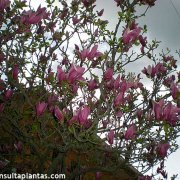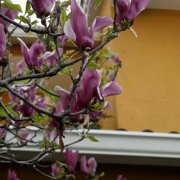Care of the tree Magnolia liliiflora or Lily magnolia |
|
The genus Magnolia, family Magnoliaceae, includes about 120 species of trees native to the American continent and Southeast Asia. Some species are: Magnolia liliiflora, Magnolia grandiflora, Magnolia boliviana, Magnolia liliifera, Magnolia stellata, Magnolia officinalis, Magnolia × soulangeana. Common names: Lily magnolia, Mulan magnolia, Purple magnolia, Japanese magnolia, Red magnolia, Tulip magnolia, Jane magnolia and Woody-orchid. This species is native to southwest China. They are deciduous trees or shrubs branching from the base that reach 4 meters (13.12 feet) in height. They are highly appreciated for the beauty of their flowers that sprout from the trunk before the leaves. The leaves are alternate, large and bright green. The spectacular flowers are large, purple-pink in color and have upright petals. They bloom in early spring. Lily magnolia is commonly used as isolated specimens, in small groups and in large pots. Magnolia liliiflora grows in full sun and semi-shade exposures. Resists light and occasional frosts. The soil must be well drained and contain abundant organic matter and peat. Planting is done in spring; if it grows in pots it can be done in any season. Water frequently in summer and slightly reduce watering the rest of the year without allowing the substrate to dry out completely. Purple magnolia does not resist drought. Fertilize with compost or manure in autumn and with mineral fertilizer in early spring. Tulip magnolia can be lightly pruned in fall to control their growth. Magnolia liliiflora is a sensitive plant to the attacks of aphids and mites. Very dry summers can cause leaf drop. Late frosts can impede flowering. Japanese magnolia is propagated by layering, by grafting and by cuttings but they are not simple processes. |
Images of the tree Magnolia liliiflora or Lily magnolia |
Find plants
Magnolia liliiflora or Lily magnolia | Care and Growing
© 2025 FavThemes



